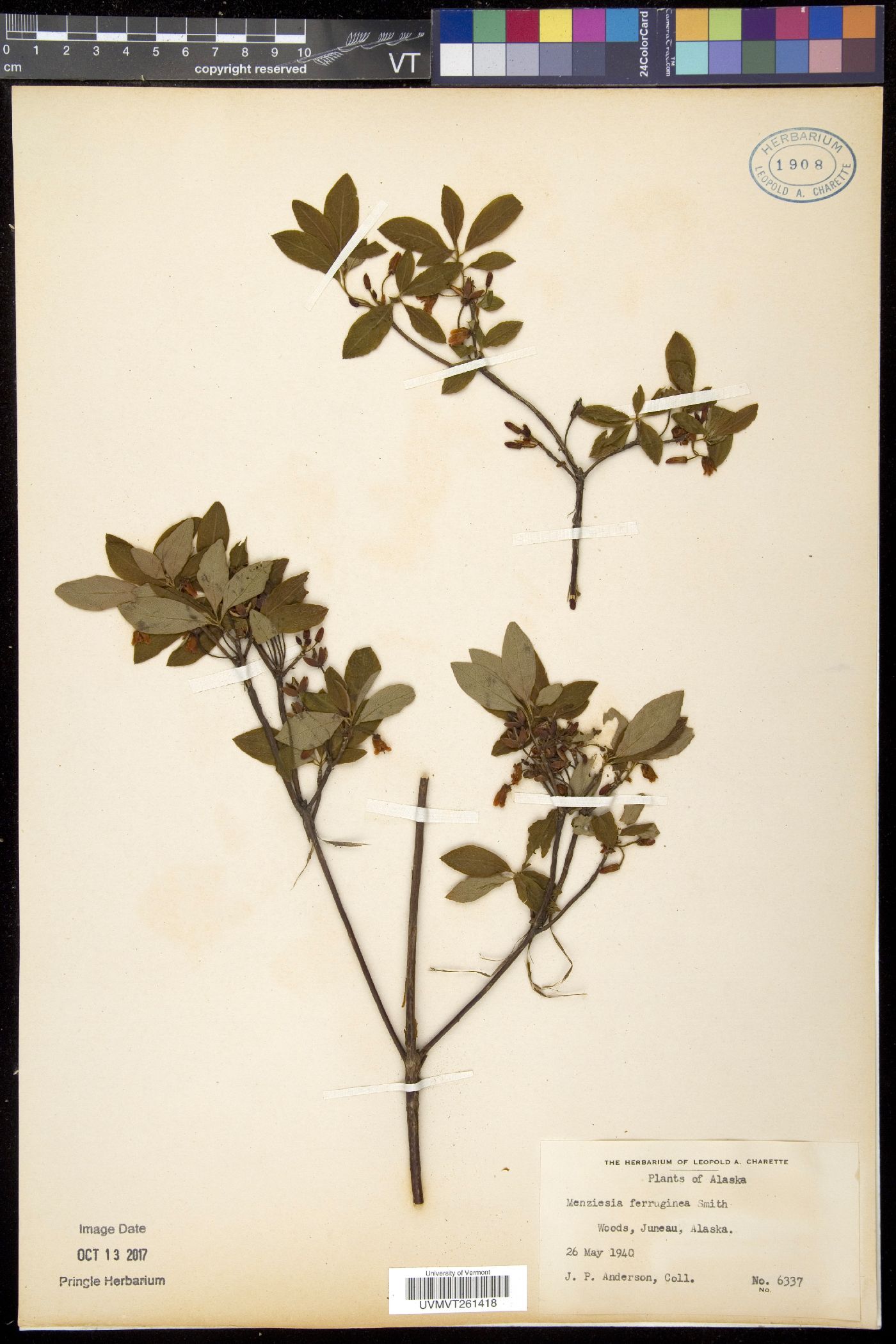
|
Family: Ericaceae |
Shrubs. Stems erect, spreading, or straggling; young twigs minutely pilose and hairy; (older twigs without peglike projections). Leaves deciduous, alternate, (crowded toward branch tips); petiole present; blade membranous, margins crenulate-serrulate, (rolled under in bud, abaxial surface 1/3+ visible except sometimes in bud). Inflorescences terminal umbelliform or corymbiform clusters on previous year´s shoots, 2-10-flowered; perulae ± persistent, scarious, margins minutely ciliate. Flowers bisexual, ± bilaterally symmetric; sepals 4[-5], connate ca. 3/4 their lengths; petals 4[-5], connate for ca. 2/3 their lengths, corolla deciduous, cylindric-urceolate, soon campanulate, (glabrous or finely puberulent adaxially); stamens 8 [5 or 10], included; anthers without awns, dehiscent adaxially by 2 longitudinal, terminal slits; ovary 4[-5]-locular; style included; stigma capitate. Fruits capsular, ovoid to ovoid-oblong or obovate, dehiscence basipetally septicidal. Seeds ca. 50-90, linear or narrowly ovoid, ± prolonged to form apiculate tip or elongate appendage, without wings; testa smooth, membranous. x = 13. A close relationship of Menziesia and Rhododendron is hypothesized based on matK analysis. The slightly zygomorphic flowers of the 5-merous Menziesia are similar to those in many species of Rhododendron. Flattened multicellular scales present on the abaxial midrib are also found in Rhododendron sect. Tsususi and on closely related Tsusiophyllum, prompting K. A. Kron (1997) to suggest including both taxa within Rhododendron. Inclusion of Menziesia within Rhododendron is implied also by matK and trnK intron sequence analysis (Y. Kurashige et al. 2001), although its exact relationship remains unresolved. Levels of genetic diversity among populations in North American Menziesia are quite low relative to gene diversity within populations as indicated by isozyme, flavonoid, and morphological studies, possibly indicating a recent evolutionary origin (T. C. Wells and B. A. Bohm 1994). Divergence between M. pilosa and M. ferruginea from a common widespread ancestor could have occurred as recently as the Pleistocene, some 300,000 to 800,000 years before present. Isozyme data suggest a time of divergence between the Coast/Cascade and Rocky Mountain phenotypes of M. ferruginea of only 60,000 to 80,000 years before present, coincident with the Wisconsin Glaciation, which may have had some effect on north-south and east-west divergences of morphological and isozyme forms (Wells and Bohm). Species of Menziesia occur in mid to late successional-stage forests in temperate to subalpine habitats. The flowers are pollinated by bumblebees (Bombus Latreille spp.) and other bees. The fine seeds are gravity-dispersed but are apparently susceptible to some dispersal by air currents.
Fls 4-merous; cal saucer-shaped, shallowly lobed; cor urceolate- campanulate, shallowly lobed; stamens 8, included; anthers linear, opening by 2 short, pore- like terminal slits; ovary 4-locular; style included; capsule short, thick-walled, septicidal; shrubs with alternate, deciduous, short-petioled lvs and umbelliform or corymbiform clusters of fls from terminal buds of the previous year. 7, N. Temp. Gleason, Henry A. & Cronquist, Arthur J. 1991. Manual of vascular plants of northeastern United States and adjacent Canada. lxxv + 910 pp. ©The New York Botanical Garden. All rights reserved. Used by permission. |
This project was made possible in part by the Institute of Museum and Library Services [MG-70-19-0057-19].
Powered by Symbiota



